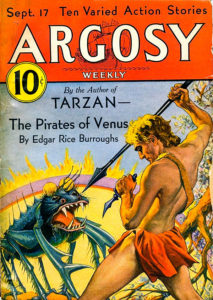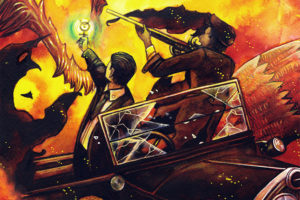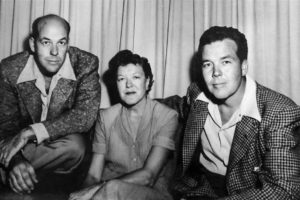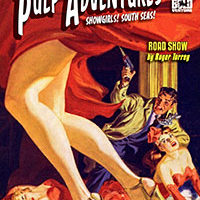
The prolific Edgar Rice Burroughs had several series set in exotic locations: Mars, the Hollow Earth, the Moon, and Venus.
I have already looked at his Mars and Pellucidar (hollow earth) series, and his last extended series was set on Venus, or Amtor as the natives called it, though most refer to it as the Venus series or the Carson of Venus series. I read the series while in high school when I was reading almost all of Burroughs’ stuff.
The series is composed of:
- “Pirates of Venus” (1934)
- “Lost on Venus” (1935)
- “Carson of Venus” (1939)
- “Escape on Venus” (1946)
- “The Wizard of Venus” (1964)
It was centered around Earthman Carson Napier, who built his own rocketship to take him to Mars. But a miscalculation sent his ship crashing on the southern hemisphere of Venus. There he finds a lush world of jungles and oceans, under an almost permanent cloud cover. Interestingly, he is a friend of Jason Gridley, who has been in contact with Tarzan and those in Pellucidar, so this creates a shared universe that places Tarzan, Pellucidar, and Venus in the same universe. I don’t recall if Mars was also tied in.
Like all the “planetary romance” stuff, Carson has adventures, usually rescuing princesses (the main one being Princess Duare whom Carson meets in the first story). She is part of the Vepajans, who have been taken over by the Thorists. These people are normal humans. So over the course of his adventures, he travels through the jungles, mountains, and across the oceans of the southern hemisphere of Venus. He also encounters a few other races, such as winged people and a kind of fishmen.
The funny thing is, the people of Venus think of their world as a flat disk, but one that has their equator as the center, and their south pole as the outer edge! Some maps of Amtor are included with some of the books.
Also, many of the stories have an element of political satire, though some may not notice it. I don’t think I did. The Thorists were thinly veiled communists, and later stories were commenting on the Nazis.
As I haven’t read them since high school, I don’t seem to recall Carson ever marrying and settling down with Duare or another princess. No adventures with Carson’s children or the like.
Comic Books
During the time DC Comics had the rights to the Burroughs properties, they also did some adaptations of the Venus stuff. They did “Pirates of Venus” (in Korak, Son of Tarzan #46-50, 52-53, partially reprinted in Tarzan Family #60-65) and started an adaptation of “Lost on Venus” (in Korak #54-56 and Tarzan #230). This with art by Michael Kaluta. I really wish this would be reprinted! I think I read some of these before reading the actual books.
When Dark Horse had the rights, they did a mini-series of Tarzan meeting Carson which was reprinted in trade paperback.
Movies
As of yet, no movies have ever been done based on these works, though a production company has optioned the rights.
Other Venuses
As I’ve noted, Burroughs was a main writer in the area of planetary romance, i.e. “sword and planet” fiction, and there were others, some of whom set their stories on Venus. Otis Adelbert Kline, Burrough’s so-called “main rival,” wrote a trio of stories set on Venus: “The Planet of Peril,” “The Prince of Peril,” and “The Port of Peril” in 1929-32. There are other stories set on a jungle Venus, but none used it to the extent that Burroughs (and maybe Kline) did.
If you have read the major series of Burroughs, moving on to the Venus series like I did is logical. Check it out if you haven’t already.




Like you, I read the DC adaptations of Carson of Venus before reading the actual novels, mainly because I was attracted to the gorgeous Michael Kaluta artwork. Then I read the books. They were alright but didn’t grab me by the throat like the Mars, Tarzan and Pellucidar books did.
Certainly one of his lesser series.
Have to wonder why there weren’t more. Especially as he was trying other series, such as the aborted “Beyond the Farthest Star”.